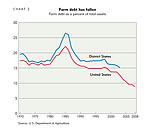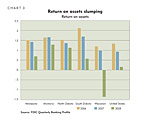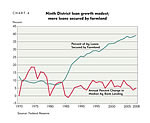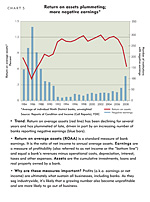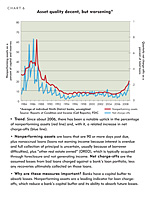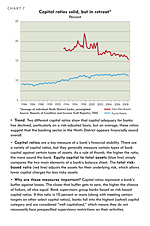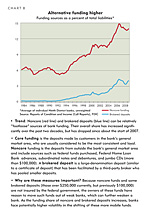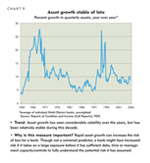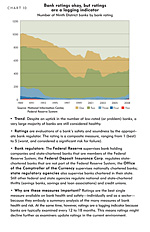With somewhat ironic deference to the Grateful Dead, what a long, strange trip it's been for banks.
By now, most people are intimately familiar with the banking crisis, even if they'd prefer not to be. The matter is ubiquitous, whether it concerns bailouts, stress tests, toxic assets, stock prices, credit crunches, you name it—in the newspapers, on the airwaves, on the Web, at cocktail parties and backyard barbecues.
Lost amid the chatter and hand-wringing, however, is the fact that banks in the Ninth District are still in comparatively good shape despite major upheaval in financial markets and the broader economy. Whether that holds is difficult to predict; trend data going back to the 1980s suggest that performance by district banks, on average, is likely to get worse before it gets better.
Yet as future bank performance rolls out, it's useful to retrace the path from whence it came. In some respects, it's difficult to grasp just how quickly things have gone off course. Indeed, the trip has been strange, but not necessarily that long.
By the middle of 2007, there was concern among bankers and economy watchers as the subprime mortgage debacle started to unfold, and even clearer signs of trouble became apparent by the end of the year, when a national recession officially began. By early 2008, the Federal Reserve was aggressively cutting interest rates and had implemented new programs to provide liquidity in the financial sector. For many, a tipping point came in March 2008, when the Federal Reserve invoked emergency powers and helped to arrange a fire sale of Bear Stearns to JPMorgan.
Still, even by last summer, the recession had not severely affected employment or output, and runaway commodity prices and $4 gas dominated the business news. To the layperson, there was no shush-the-kids, oh-my-gosh economic moment until the middle of September 2008, when the bankruptcy of Lehman Brothers, the government rescue of AIG and a cascade of other events helped trigger what would ultimately become a global economic crisis.
So much has happened since last September that it almost feels like a time warp: Doesn't the now-comparative calm of 12 months ago feel like 12 years ago?
All recessions hit the financial services sector eventually. But problems in the financial sector have been the defining elements of this recession, from its beginnings in the subprime mortgage market to the extraordinary bailouts and policy measures of the past 12 months. Rather than follow other sectors into an economic slowdown, banks and other financial institutions have led the way into this recession. But it wasn't a group effort, at least not at first. The implosion of the financial services sector—everything from banks to investment firms to rating agencies—mainly snared the biggest conglomerate banks that were involved in troubling investments such as subprime mortgages, collateralized debt obligations and credit default swaps.
The ensuing melee has put banking in the public spotlight, which also means the industry gets painted with broad strokes. If the big banks are seemingly a congressional whim away from failure, how close are the rest to the abyss?
In fact, regional and community banks have been largely unaffected by the so-called toxic asset controversy surrounding subprime mortgages. But over time—a fairly short time, in reality—plunging bank profitability suggests that the industry has come to feel the effects of the broader recession. Thanks to this simultaneous top-down and bottom-up pressure, 2008 will go down as a scarlet-red-letter year for banks across the country and the Ninth District. However, despite obvious signs of decline and stress, most district banks today still appear healthy, particularly compared with the nation's banks as a whole.
For broader perspective, it helps to take a comparative look at history. The last full-blown banking crisis took place in the 1980s and hit particularly hard in Minnesota and many rural agricultural areas of the district. This time, although health indicators have worsened considerably in the past 18 months or so, and appear likely to decline further, banks in the Ninth District have some financial strength remaining to help them withstand this bout of economic flu.
Let's not do this again, hmm?
The best thing that might be said about 2008 is that at least it lasted only 12 months, as banks watched the economy and their own health metrics take a nosedive, particularly in the last three months of 2008.
Charts 1 and 2. Noncurrent
loans and leases rising; Net
charge-offs climbing
Net income, for example, plunged 80 percent at banks nationwide in 2008, and by 60 percent in both Minnesota and South Dakota, according to data from the Federal Deposit Insurance Corp. (FDIC). In Wisconsin, net income swung from a $1.2 billion profit to a $1.5 billion loss, mostly on the heels of large losses at Marshall & Ilsley Corp., parent of M&I Bank, the state's largest bank. The amount of past-due loans and loans written off by banks as uncollectible also rose steeply in all district states, though more in some than others; certain states like Montana still have rates for these important measures that are relatively low (see Chart 1 and Chart 2). (Note: For comparison purposes, the accompanying charts include all commercial banks in Wisconsin, some of which are not in the Ninth District.) View a slideshow of all charts.
Charts 3 and 4. Return on
assets slumping; More
banks unprofitable
Not surprisingly, return on assets (ROA) took a similar beating in 2008 compared with a year earlier for banks in most district states, and the number of unprofitable banks also surged. On both of these measures, however, district banks in general fared much better than those nationwide (see Chart 3 and Chart 4).
More disconcerting is the fact that bank losses accelerated steeply over the course of the year. For example, nearly one-third of U.S. banks were unprofitable in the fourth quarter of last year, significantly worse than the nationwide annual rate of 22 percent in 2008. In Wisconsin, 11 percent of banks were unprofitable last year, but 28 percent lost money in the last quarter of 2008.
Though much of the carnage occurred in the fourth quarter of last year, 2008 was not in line to be a banner year even before the financial collapse last fall. Indeed, a close look at the data shows that virtually all of the indicators mentioned above had worsened across the board in 2007, though mostly by fairly small amounts.
Among district states, Minnesota and Wisconsin banks have probably fared the worst of late. (South Dakota's performance has also been poor, but is a special case as discussed below.) The two states have seen some of the steepest declines among the various performance measures. Total bank employment, for example, has dropped two consecutive years in Minnesota, worse than the national trend, which saw employment drop only in 2008. The state was also on the low end of deposit growth in 2008 (at 4 percent), which doesn't include a $6.8 billion deposit migration when Wells Fargo Bank South Central of Faribault, Minn., a mortgage-related subsidiary of Wells Fargo, relocated its offices to Alaska.
Banks in North Dakota and Montana have performed comparatively well to this point. Net income has dropped less than 10 percent since 2006 in the Peace Garden state, and the number of unprofitable banks remained in single digits in 2008 for both states. Banks in each state continue to have low levels of noncurrent loans and net charge-offs, probably due in part to the outsized effects of strong farm and energy sectors in both states last year. However, if this crisis has shown anything, it's that conditions can change, and quickly.
As might be expected given the circumstances, growth of new branch offices has slowed. In 2007, a total of 130 new bank offices were opened in the five district states and the Upper Peninsula of Michigan, according to the FDIC. That number fell to 88 last year, and only 11 opened after mid-September. Through early May of this year, just 14 new offices had opened in the five states; eight in Wisconsin and none in Montana, South Dakota or the U.P.
The total number of bank offices is still growing slowly nationwide, but has fallen in the district, which breaks a decades-long growth trend. From 2006 through 2008, U.S. banks added about 500 net new locations (about one-half of 1 percent). In the same period, the total number of bank offices in the Ninth District actually dropped a bit—by 58 locations, or about 1 percent—from a high in 2006. Though it has comparatively few bank offices, the Upper Peninsula saw a particularly large percentage drop of 17 percent over this period, and currently has 160. The slow-drip trend in district bank offices overall is likely to continue. AnchorBank of Madison, Wis., for example, announced in April that it would close three of its 76 branch offices in the state by the end of summer.
On the whole, however, Ninth District banks do not appear to have experienced the same level of difficulty as their peers nationwide. For example, 57 U.S. banks have failed from January 2008 through early May of this year; only one is in the Ninth District—First Integrity Bank of Staples, Minn., in May of 2008. Most annual performance metrics also give a decided edge to district banks.
There are some caveats, however, regarding district-to-nation comparisons. Nationwide figures for many stress indicators are skewed higher—by how much is not known exactly—by the disproportionate number of very large banks that are struggling. Though small in number, these banks hold a majority of bank assets, and their performance can have an outsized effect on cumulative bank performance if the sector is viewed as one large entity—everyone pooled together—rather than as the average performance of individual banks.
In fact, South Dakota offers just such an example in the district, because it is the charter home for Wells Fargo. By most measures, Wells Fargo has performed better to date than its goliath peers; though it lost money in the fourth quarter of last year, it was still profitable for the year and surprised the market with a $3 billion profit in the first quarter of this year.
Still, its 2008 performance lagged compared with 2007, and when Wells Fargo sneezes, the banking sector in South Dakota looks like it caught a cold, especially compared with other district states. For example, net income for Wells Fargo fell from $8 billion in 2007 to $2.8 billion last year—about 90 percent and 80 percent, respectively, of the net income of all South Dakota banks. Net charge-offs for Well Fargo doubled from 1 percent in 2007 to 2 percent last year; the bank wrote off $7.8 billion in loans last year, more than 90 percent of the $8.5 billion written off statewide; indeed, that represents about 70 percent of write-offs in all five district states. Results of the widely touted stress tests of the largest 19 U.S. banks by federal regulators showed Wells Fargo needed to raise $14 billion in additional capital.
Historical, or hysterical, comparisons?
The shock and trajectory of the current banking crisis has brought with it historical comparisons to the last banking crisis, which occupied much of the 1980s.
That collapse was really two separate crises among financial institutions. One involved commercial banks (and is the focus here). But there was a second, coincidental collapse among savings and loans, which stemmed from factors both similar and different from the commercial bank collapse. In all, about 2,000 banks and thrifts failed during the decade, including 1,400 commercial banks—about 25 times more than the tally from the current crisis through early May. The 1980s crisis spanned virtually the entire decade; the trajectory and length of the current crisis is unknown now that the banking sector has again become stressed.
Still, given today's economic and banking environment, it's useful to compare current banking indicators with those of banks during the 1980s to see what might be learned, and what path might lie ahead for the sector. So the Federal Reserve Bank of Minneapolis compiled historical data on a number of bank-health metrics, looking at average or median performance among all banks, rather than cumulative performance of banks as a single entity.
(Note: Much of the historical data on banks go back only to 1984, which is in the midst of the commercial banking crisis, but before the peaks in most indicators of weak performance. This analysis also covers only banks specifically within the Ninth District, which includes the Upper Peninsula of Michigan and 26 counties in northwestern Wisconsin.)
Broadly speaking, various indicators show that the banking sector is ailing. At the same time, a variety of measures suggest that overall, banks are considerably healthier than they were during the 1980s.
Chart 5. Return on assets
plummeting; more negative
earnings
At first blush, the comparison with the 1980s looks unnerving. The first place most bankers look for trouble is their bottom line. Return on assets, a common benchmark in banking, has fallen steeply of late, reaching levels last seen during the 1980s (see Chart 5). This is due to a number of factors (discussed below), but reflected in the fact that the number of district banks with negative earnings has also risen significantly.
Another indicator of falling profitability is a decline in net interest margin (NIM). This is the difference or "spread" between what the bank pays for funding (like its deposits) and what it earns by lending that money to various borrowers. NIM is the business model upon which commercial banking is built—find cheap funding, and make money lending it to other people at higher interest rates. NIM tends to stay within a fairly tight range—roughly between 4 percent and 5.5 percent. But it has been gradually declining since the latter half of 2005, and the 4.1 percent average NIM reading in the fourth quarter 2008 was the lowest since 1987.
Chart 6. Asset quality
decent, but worsening
Banks also are seeing a higher rate of "nonperforming assets"—bankspeak for loans or other assets that are 90 days or more past due or otherwise in arrears, and often not earning the contractual rate of interest. Banks ultimately write off a certain number of bad loans that they believe are uncollectible. When this happens, the losses are charged against (or subtracted from) available capital. These charge-offs have risen fairly steeply of late (see Chart 6).
Banks must also "provision" against future losses. That is, after reviewing economic and loan-specific factors that help forecast loan losses, banks charge themselves an expense, which reduces earnings. The offset to the expense is a loan loss reserve.As might be expected in light of other indicators, provisions have jumped in the past year; from the first quarter of 2008 to its final quarter, total provisions as a percentage of loans have increased by about 250 percent in the district. Rising provisions can also be seen in the number of unprofitable banks (see Chart 5).
Chart 7. Capital ratios
solid, but in retreat
Despite the unflattering increases among all of these indicators, none is close to peak levels witnessed in the 1980s. Other metrics give a mixed report card on the health of district banks. For example, regulators also look at capital ratios—in essence, the amount of capital or equity compared with assets. On a basic level, over the past 25 years, banks have seen dramatic improvement in their equity-to-asset ratio (see Chart 7). When assets are adjusted for underlying risk of repayment, however, the picture changes; after a notable drop in risk-adjusted capital ratios after the 2001 recession, these ratios have continued to slide slightly lower and recently fell below 16 percent. Still, regulators view a bank with a 10 percent ratio as well capitalized.
Adding to concerns, banks have seen a sizable increase in funding sources that are more footloose and potentially expensive.
Chart 8. Alternative
funding higher
Beyond what you might think, bank assets have continued to grow even during the current crisis. In fact, total bank assets have not declined in any year going back at least to the 1950s. This naturally raises concerns given that a 1997 FDIC study of the 1980s crisis found that fast loan growth was an early indicator of problem banks.
Chart 9. Asset growth
stable of late
On this measure, asset growth has been comparatively stable for the past half dozen years or so—in the 8 percent to 10 percent range, well below the spikes seen in the 1980s, as well as during the boom years of the late 1990s (see Chart 9).
Add up these (and sundry other) performance indicators for most banks in the Ninth District, and you get a picture of a banking sector that is back on its heels, maybe a bit bloodied, but with enough stamina left to stay upright despite poor economic conditions.
At least that's the view of regulators, who continue to favorably rate the large majority of banks. Cumulative bank ratings (from all three federal regulatory agencies, as well as state bank regulators) are only available back to 1989—after the peak of the commercial banking crisis, when overall bank ratings were on the mend. Still, current bank ratings remain better overall than they were even then.
Chart 10. Bank ratings okay,
but ratings are a lagging
indicator
In the first quarter of 1989, for example, despite being on the tail end of the crisis, one in five district banks had a poor rating (3, 4 or 5, the last of which is considered an indication of imminent failure). The percentage of poor ratings subsequently plunged to the low single digits and remained there through about 2006, when it began to rise, slowly at first, before spiking in the last three quarters of 2008. Still, barely 14 percent of banks have a poor rating (see Chart 10).
At the same time, however, cumulative ratings are a lagging indicator because banks are typically examined every 12 to 18 months. This means ratings might decline further as examiners update ratings.
How far to the forest boundary?
The slope of virtually all the historical indicators suggests that the banking sector is not out of the woods yet. Almost certainly, conditions will worsen before they get better, and some banks will experience significant difficulty, even failure.
Aside from all of the data, there are also some contextual factors to consider regarding historical comparisons. For example, none of this discussion includes the carnage among savings and loans and other thrift institutions during the 1980s. From 1980 to 1988, there were 563 S&L failures nationwide, including 190 in 1988. There were also 333 supervisory mergers and almost 800 voluntary mergers, which the FDIC said were "technical failures," but didn't cost the federal government anything in terms of deposit insurance payouts. If S&L ratings and other performance data were included in this analysis, the current environment would likely look better compared with the 1980s.
In fairness, however, a large number of nonbank mortgage firms have also failed—MortageDaily.com puts the figure at more than 300 since 2006. They include the likes of New Century (at one point, the second-largest subprime lender in the country) and Fannie Mae and Freddie Mac, the mortgage behemoths that are now in government conservatorship.
Many people also point to much higher interest rates in the 1980s as an important difference compared with the current crisis. The federal funds rate, which is the target rate of interest for depository institutions lending their Federal Reserve balances to other institutions overnight, bobbed in double digits for much of the first half of 1980s, spiking as high as 20 percent as the Fed tried to rein in high inflation. Today, the rate is practically zero (technically, it's being targeted between zero and 0.25).
But from a banking standpoint, nominal interest rate levels aren't particularly important; rather, net interest margins are important—borrowing capital cheaply while lending high. The business model for banks is based on simply lending money at higher rates than the bank is paying for its deposits. As mentioned earlier, despite much lower interest rates today, NIM is currently at levels last seen in the 1980s. (See charts of historical NIM)
Some similarities between the current and 1980s bank crises are worthy of attention. Both occurred in the midst of a deep recession, but have roots outside of those economic contractions. Prior to each recession, for example, there was a period of expanding credit and rapid real estate appreciation. The 1980s crisis was a series of rolling regional recessions predicated on an earlier boom in a particular sector. The first was in agriculture, and specifically farmland. But other busts followed in oil and commercial real estate, with each hitting a region of the country harder than others.
The Ninth District was witness to boom-and-bust cycles in oil and farmland. Oil prices, for example, generated immense activity in the oil-bearing areas of the district—mostly western North Dakota and eastern Montana—through the late 1970s and into the 1980s.
Because of farming's presence across the Ninth District, the bubble in farmland values had a greater effect on district banks. Between 1980 and 1993, 67 banks in the Ninth District failed, and two-thirds of them were ag banks. But ag banks accounted for less than one-quarter of bank failures nationwide during the 1980s. (For more discussion on the current health of ag banks in the Ninth District, see Ag Banks: A walk down (bad) memory lane?)
The FDIC analysis of the 1980s crisis has found (as has other research) that concentrations of loans in a particular sector put a bank at higher risk of problems and possible failure. Agriculture's share of total loans among district banks reached about 25 percent at one point during the 1980s. But even that figure is understated, because banks in agricultural areas routinely had much higher concentrations of ag loans. So when the farm economy went south, the solvency slope for farmers and bankers got too slippery, too quickly.
Chart 11. More
concentration
in
commerical real estate
Nationwide, a similar overinvestment occurred in commercial real estate loans in the 1980s, according to the FDIC study, and was responsible for a significant share of failures that decade, mainly outside the district. Now fast-forward to the current banking crisis: Over the past 25 years, district banks have steadily increased their exposure to commercial real estate (see Chart 11), and there are signs of trouble in the sector. For example, charge-offs on construction and land development loans in the five district states leapt from $212 million in 2007 to almost $1.5 billion in 2008, according to FDIC data, roughly two-thirds of it occurring in Wisconsin banks.
As the philosopher George Santayana said roughly a century ago, those who cannot remember the past are condemned to repeat it. Still, despite reams of data on current and past banking conditions, predicting the trajectory of the current banking crisis is guesswork. The exhaustive FDIC report on the 1980s bank crisis found "no single cause or short list of causes." Rather, it resulted from a concurrence of forces—economic, financial, legislative and regulatory—working together to produce a decade-long crisis among banks, many of which "gave few obvious signs that the competitive environment was becoming more demanding or that serious troubles lay ahead" for them.
Many of those forces are at work again in the banking sector. Few would have predicted such a uniquely memorable and forgettable 2008. With history as a conductor, the rhythm of this bank crisis might seem similar to others that have come before it. But try as you might, you're not likely to name that crisis tune until the song is over.
See additional, historic performance indicators of Ninth District banks.
Ron Wirtz is a Minneapolis Fed regional outreach director. Ron tracks current business conditions, with a focus on employment and wages, construction, real estate, consumer spending, and tourism. In this role, he networks with businesses in the Bank’s six-state region and gives frequent speeches on economic conditions. Follow him on Twitter @RonWirtz.





